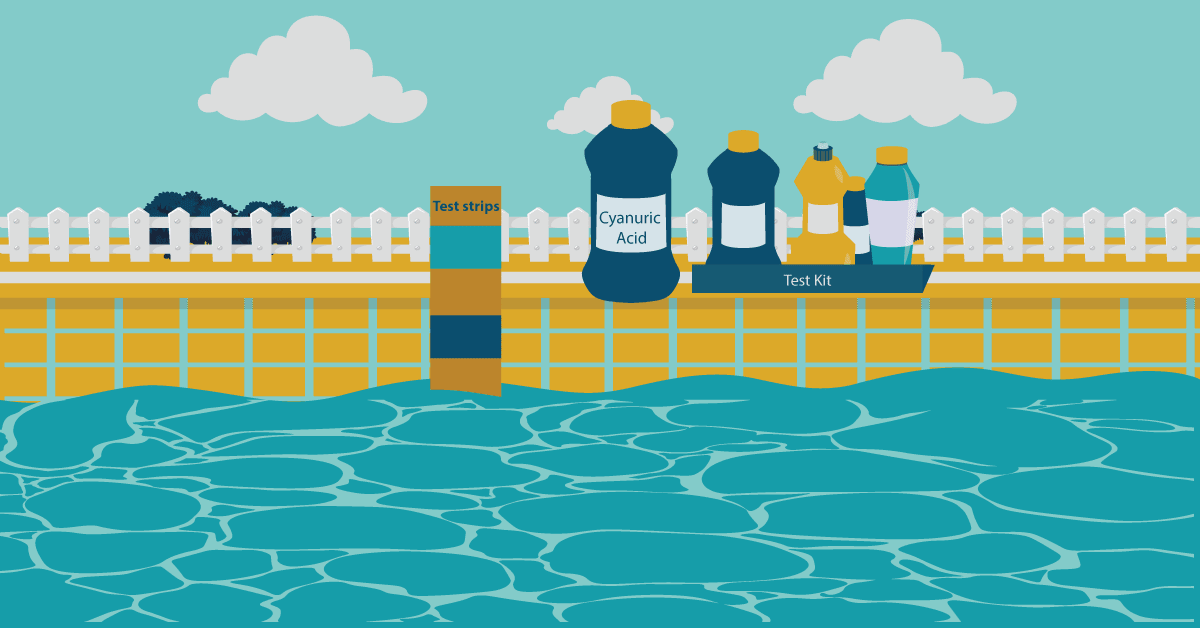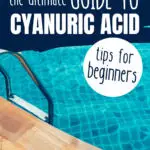Chlorine alone doesn’t make a pool safe. Without it’s ‘assistants’ chlorine doesn’t do enough and/or last long enough. Low cyanuric acid in a pool causes problems, and may even make the water unsafe to swim in.
Continue reading for our pool care tips, we also take the hard stuff out of water chemistry. We want you to spend less time worrying about pool chemicals and more time swimming!
What Is Cyanuric Acid?
Otherwise known as pool conditioner or pool stabilizer, cyanuric acid is a must-have in your pool. It’s not just any old chemical – it’s the ‘assistant’ chlorine needs to keep your pool sanitary.
Using cyanuric acid, sometimes abbreviated CYA, protects chlorine from sunlight. Without it, the sun’s ultraviolet UV rays break down the chlorine’s ions, rendering it useless.
- Cyanuric acid for pools
- Helps reduce chlorine loss
- Recommended cyanuric acid level is 40-100 ppm
- 6 ounces raises cyanuric acid level 10 ppm per 5,000 gallons of water
- Increases cyanuric acid level
The right amount of cyanuric acid levels in a pool reduces the amount of chlorine needed to keep the pool clean. In short, it decreases the cost of owning a pool.
When used together, cyanuric acid work together with free chlorine to allow it to last three to five times longer due to the proper water-balance protection created by the cyanuric acid.
How Does Cyanuric Acid for Pools Work?
CYA stabilizes the chlorine or stops the ions from breaking apart. The sun’s rays damage the chlorine ions, making them useless. This increases your pool’s chlorine needs and puts your pool at risk of more contaminants.
CYA bonds to the chlorine ions (chlorine transforms into sodium hypochlorite ions first), keeping them together. Without cyanuric acid, your pool is at greater risk of bacterial growth much faster.
Why Your Swimming Pool Needs Cyanuric Acid
Swimming pools need cyanuric acid if you don’t want to swim in bacteria, algae, or other contaminants.
It takes just 17 minutes after putting chlorine in the pool for the sun’s UV rays to separate the ions and kill off more than half of the ‘free chlorine.’ If you didn’t use cyanuric acid in the pool, you’d need more 7 – 8 times the chlorine levels in your pool.
Higher chlorine levels make it uncomfortable and even dangerous to swim. Too much chlorine may cause skin irritation. The gases the water gives off with too much chlorine can also cause nose and eye irritation. There’s even such a thing as chlorine poisoning, even though it’s rare – there’s still a risk hence the reason your pool needs cyanuric acid.
So, why does all of this actually matter? Pools contain three different types of pool chlorine: free, combined, and total chlorine.
- Free chlorine is the measurement of how much sanitizer your pool water has in it. This happens when you add additional chlorine into your pool, or if you have a salt water chlorinator that produces it too.
- Combined chlorine is the measurement of sanitizer that you’ve used to kill bacteria in your pool already.
- Total chlorine is the combination of both free and combined chlorine.
Cyanuric Acid Pool Ideal Levels
Your pool needs the right cyanuric acid levels to keep it safe, and to lengthen the chlorine’s use, but there’s such a thing as too much of a good thing. If your levels are off, sometimes you will notice an off odor as well.
For example, kids could swallow it. In fact, we know kids will swallow it – even adults can’t help but get some swimming pool water in their mouths. Too much cyanuric acid concentration can make a person sick. Because of this, the World Health Organization set parameters, stating that pools shouldn’t have more than 100 ppm (parts per million) of cyanuric acid when using chlorine for sanitation.
Aim for 50 ppm not only to err on the side of caution, but also to keep everyone safe.
Benefits vs Downsides of Cyanuric Acid in Pool
Not enough cyanuric acid makes your pool unsafe, but too much is just as unsafe. The right amount, though, helps your chlorine work effectively, keeps the pool clean, and makes it safe to swim.
Are there downsides?
Only if you use too much, or too little, but we’ll focus on overuse. Under use is easy to fix. Overuse poses serious threats.
You’d think more cyanuric acid makes the chlorine work longer or harder. It doesn’t.
Using too much cyanuric acid may even backfire and cause the chlorine to stop working. Next thing you know, you have algae and bacteria growing, defeating the purpose of cyanuric acid in the pool.
There’s a perfect balance you must strike. You need just enough CYA so the chlorine balances out, lasts long, and kills the bacteria and contaminants in the pool.
How to Test Your Cyanuric Acid Levels
Taking a weekly reading of the current state of your pool is an important part of regular pool maintenance. You don’t need to work in the pool industry to be an expert in pool chemistry either.
When testing your free chlorine levels – try to keep them between 1 ppm and 3 ppm. The general rule of thumb is to keep your free chlorine levels around 7.5 percent of your cyanuric acid levels. That would mean your CYA should fall between 30 ppm and 50 ppm.
All you need to do on a regular (weekly) basis is check your levels to prevent algae and other bacteria from taking over your pool.
You can test you for cyanuric acid levels in the pool the same way.
Get some test strips to keep an eye on your different levels including pH and cyanuric acid levels. An alternative option is to take a sample to a local pool store near you.
- Features a photometer which gives you a digital reading of test results.
- Water resistant housing and carrying case provided.
- Tests Free Chlorine, Total Chlorine, Bromine, PH, Alkalinity, Calcium Hardness, and Cyanuric Acid.
- Uses liquid reagents for all test factors except Cyanuric Acid, which uses tablets.
Whether you buy a complex testing kit that includes cyanuric acid testing or you buy strips just for CYA testing, make sure you test your levels.
Strips just dip into a sample of swimming pool water and tell you the levels. Kits sometimes require you to add a chemical to a pool water sample to test the levels.
If you’re ever in doubt – grab a sample of pool water and head to your local pool store. Most stores test pool water for you.
You’ll get one of three results – your CYA levels are just right, too low, or too high.
How to Lower Cyanuric Acid in Pool
If your testing indicates that you need to reduce cyanuric acid levels because they are too high, it’s important that you lower them as quickly as possible or before anyone swims in the pool.
Diluting the water is the best cyanuric acid reducer. If your water is already at capacity, let the water splash out so you can refill it with fresh water. Empty as much water as your cyanuric acids are high. If the water tester shows your CYA is 3% too high, empty out 3% of the water and dilute the rest.
If you have an extremely high level, it’s best to empty the pool and start again. If this happens, change the filter and/or backwash the filter too – chemicals tend to linger, leaving you in the same position you were before you emptied the pool.
That’s only in extreme cases, but if you don’t keep a careful eye on the levels and correct any high levels right away, it could happen.
If you’re using a small above ground pool, it is sometimes faster to empty and refill the entire pool after cleaning the pool liner with disinfectant, soaking the pool pump and pool filter and sanitizing anything that was perhaps left in the pool such as your ladder or other aquatic toys.
What Causes Cyanuric Acid to Be High in a Pool?
Many pool owners use stabilized chlorine tablets for convenience. There’s no measuring or pouring chemicals – it’s perfect.
Here’s the problem.
Most people automatically add cyanuric acid without reading labels when they add chlorine tablet ingredients. Many tabs are already containing cyanuric acid, which is why most don’t realize that they’re even adding cyanuric acid too.
If you want to add your own cyanuric acid for pools, look for chlorine tablets without it. They’ll have the following names:
- Sodium dichloro-s-triazinetrione
- Trichloro-s-triazinetrione
- 1 to 3 tablets per 10,000 gallons of water
- Maintain the pH at 7.4-7.6 and total alkalinity at 80-130 ppm
Another possibility – not testing the water. Even if you don’t add your own CYA, stabilized chlorine tablets often add too much CYA to the water, making it unsafe. Choose cyanuric acid-free chlorine and add it yourself to stay on the safe side or get ready to use one of the cyanuric acid reducer methods.
Effects of High Cyanuric Acid in Pool
High cyanuric acid in the pool does two things:
- Creates a dirty pool because the chlorine gets obliterated
- Wastes money on both the chlorine and the cyanuric acid
Ultimately, too much cyanuric acid in the pool is like throwing money out the window. When the chlorine is depleted fast, you either have to buy more or don’t swim in the pool – neither of which is a great option.
How to Raise Cyanuric Acid in Pool
Lacking cyanuric acid is a good problem, if there is such a thing. While it means you’re chlorine won’t last long, it’s an easy fix.
Add more cyanuric acid in the pool, but go slowly. Add too much and you have the opposite problem – too much CYA. Read the manufacturer’s directions or talk to your local pool supply store.
- Cyanuric acid for pools
- Helps reduce chlorine loss
- Recommended cyanuric acid level is 40-100 ppm
One pound per 5,000 gallon of water will make your pool gain approximately 25 ppm of CYA.
Add a little bit and test the water again. It’s easier to add more than it is to correct the problem (diluting the water).
Bottom Line
The perfect amount of cyanuric acid in the pool creates that ‘sweet spot’ pool water needs. It helps the chlorine work right and last longer and you’ll keep swimmers safe.
Too much CYA in the pool and the chlorine stops working, the water becomes contaminated, and the swimming pool water needs draining.
Stay on top of your pool’s chemical levels by testing them often. If you’re unsure, talk to a pool specialist. Don’t mess around with less than healthy pool water, or you put your health and the health of other swimmers at risk.

For over 15 years, Sean Moore has been sharing his love and enthusiasm for swimming pools and hot tubs with everyone he knows. His goal is to help everyday people DIY their maintenance to save money by teaching how to properly take care of your equipment, safely and correctly balance chemicals, and extend the life of your water oasis.
Pricing on this page was last updated on 2024-04-26






